10 Endangered species in singapore
Lesser Adjutant Stork (Leptoptilos javanicus), Raffles' Banded Langur, Greater Mouse-Deer (Tragulus napu)

1., Raffles' Banded Langur:
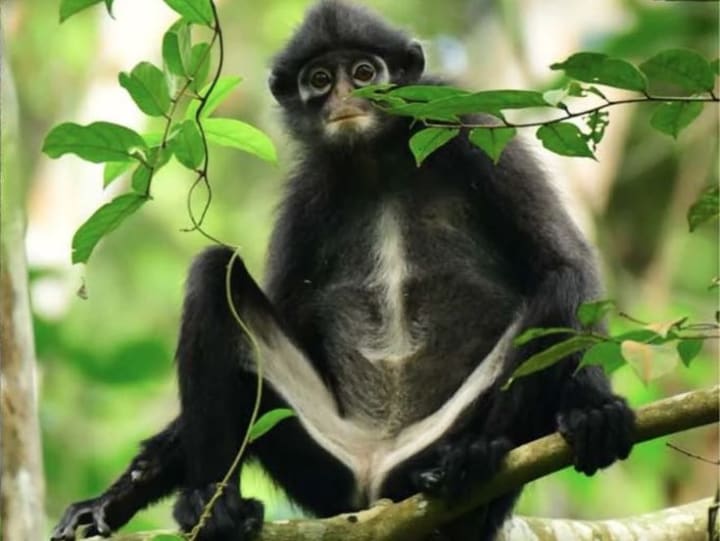
Raffles' Banded Langur (Presbytis femoralis femoralis) is an endangered primate species found in Singapore and parts of Malaysia. It is also known as the Banded Leaf Monkey or Banded Surili. Here are some key facts about Raffles' Banded Langur:
Appearance: The langurs have a striking appearance with black fur and prominent white stripes running across their thighs, giving them their "banded" name. They have a long tail and a white beard.
Habitat: They inhabit primary and secondary forests, including mangrove forests and coastal areas. In Singapore, they are primarily found in the Central Catchment Nature Reserve and Bukit Timah Nature Reserve.
Diet: Raffles' Banded Langurs are primarily folivorous, feeding on leaves, fruits, and flowers. They have a specialized digestive system to process their high-fiber diet.
Social Behavior: They live in groups consisting of several individuals, usually comprising one adult male, multiple adult females, and their offspring. They engage in social interactions and grooming to maintain social bonds.
Endangered Status: The species is listed as endangered due to habitat loss, fragmentation, and human activities such as deforestation and urbanization. The langurs face significant threats from habitat destruction, roadkill, and hunting.
Conservation Efforts: Singapore's National Parks Board (NParks) and various local organizations are involved in conservation efforts to protect Raffles' Banded Langur. Initiatives include habitat preservation, monitoring, and public education to raise awareness about the importance of their conservation.
2., Sunda Pangolin (Manis javanica):
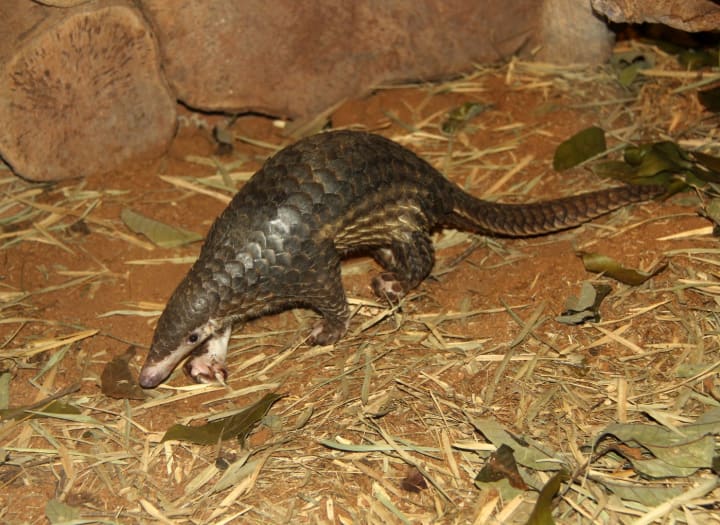
Certainly! Here are the full details about the Sunda Pangolin (Manis javanica):
Description: The Sunda Pangolin, also known as the Malayan or Javan Pangolin, is a unique mammal known for its distinctive scaly armor. It is the only scaly anteater found in Southeast Asia. They have a stocky body covered in large, overlapping scales made of keratin, which give them a reptilian appearance.
Size: Sunda Pangolins are relatively small, measuring around 50 to 70 centimeters (20 to 28 inches) in length from the snout to the base of the tail. They weigh between 1.5 to 7 kilograms (3.3 to 15.4 pounds), with males typically larger than females.
Habitat: The Sunda Pangolin is primarily found in tropical forests, grasslands, and plantations across Southeast Asia, including Malaysia, Indonesia, Thailand, Singapore, and parts of Cambodia and Vietnam. They are excellent climbers and spend much of their time in trees but are also known to inhabit burrows or dense vegetation on the ground.
Diet: Sunda Pangolins are insectivores, feeding primarily on ants and termites. They use their long, sticky tongue to capture their prey from nests and anthills. With no teeth, they rely on powerful stomach muscles and swallowed stones to grind the food in their stomachs.
Behavior: These solitary and nocturnal creatures are generally shy and elusive. They are skilled diggers and can excavate burrows for shelter and to locate ant or termite nests. When threatened, they curl up into a ball, using their sharp-scaled tail as a defense mechanism.
Endangered Status: The Sunda Pangolin is listed as critically endangered on the IUCN Red List. They face severe threats primarily due to illegal wildlife trafficking, driven by the demand for their scales, which are used in traditional medicine, and their meat, considered a delicacy in some cultures. Habitat loss and fragmentation are additional threats.
Conservation Efforts: Numerous organizations and governments are working to protect the Sunda Pangolin. Efforts include anti-poaching measures, raising awareness about their conservation status, and establishing protected areas. Organizations collaborate to combat illegal wildlife trade and rehabilitate confiscated pangolins for release into the wild.
Reproduction: Sunda Pangolins have a relatively low reproductive rate. Females give birth to a single offspring, which clings to their mother's back for the first few weeks of life. The young pangolin matures slowly and becomes independent after several months.
The Sunda Pangolin plays a vital role in the ecosystem by controlling ant and termite populations. Protecting their habitats and combating illegal trade are crucial to ensuring the survival of this remarkable and endangered species.
3., Malayan Box Turtle:

Description: The Malayan Box Turtle, also known as the Amboina Box Turtle, is a species of freshwater turtle belonging to the Geoemydidae family. It has a domed shell (carapace) that can vary in color, ranging from dark brown to black, with distinct yellow or orange markings. The plastron (lower shell) is typically lighter in color.
Size: Malayan Box Turtles are medium-sized turtles, with adult males typically measuring around 15 to 20 centimeters (6 to 8 inches) in carapace length. Females tend to be slightly larger, reaching lengths of up to 25 centimeters (10 inches).
Habitat: These turtles are native to Southeast Asia, including Malaysia, Indonesia, Thailand, Singapore, and surrounding regions. They inhabit a variety of freshwater habitats such as rivers, streams, swamps, and ponds with dense vegetation and muddy bottoms.
Diet: Malayan Box Turtles are omnivorous, feeding on a wide range of food sources. Their diet primarily consists of aquatic plants, algae, insects, worms, snails, small fish, and carrion.
Behavior: These turtles are primarily active during the day (diurnal). They are known to be excellent swimmers and climbers. When threatened, they retract their head, limbs, and tail into their shell, closing the hinged plastron, providing protection.
Reproduction: Malayan Box Turtles are known to reach sexual maturity around 7 to 10 years of age. Females lay clutches of eggs in terrestrial nests dug in sandy or loamy soil near water bodies. The incubation period lasts for approximately 60 to 90 days, depending on environmental conditions.
Conservation Status: The Malayan Box Turtle is listed as vulnerable on the IUCN Red List. The species faces threats from habitat loss due to urbanization, agricultural expansion, and pollution. Additionally, they are collected from the wild for the pet trade, further impacting their populations.
Conservation Efforts: Various conservation organizations, governmental agencies, and wildlife authorities are involved in efforts to protect the Malayan Box Turtle. Conservation initiatives include habitat preservation, captive breeding programs, and public education to promote responsible pet ownership and discourage the illegal wildlife trade.
It is important to ensure the preservation of the natural habitats of the Malayan Box Turtle and to discourage the capture and trade of wild individuals to safeguard their populations and the overall biodiversity of freshwater ecosystems.
4., Hawksbill Turtle (Eretmochelys imbricata):

Certainly! Here are the full details about the Hawksbill Turtle (Eretmochelys imbricata):
Description: The Hawksbill Turtle is a medium-sized marine turtle known for its beautiful, overlapping scutes on its carapace (shell). It has a distinctive hooked beak, which gives it its name. The carapace coloration varies from brown to amber, with intricate patterns of overlapping scales.
Size: Adult Hawksbill Turtles typically measure around 70 to 90 centimeters (27 to 35 inches) in carapace length and weigh between 45 to 90 kilograms (100 to 200 pounds). However, larger individuals have been reported, reaching up to 110 centimeters (43 inches) in length.
Habitat: Hawksbill Turtles are found in tropical and subtropical waters of the Atlantic, Pacific, and Indian Oceans. They inhabit coral reefs, rocky areas, lagoons, and coastal habitats, often in close proximity to their food sources.
Diet: Hawksbill Turtles are primarily spongivorous, feeding on marine sponges. They have a specialized beak that allows them to reach into crevices and feed on the sponges. They also consume other invertebrates, such as jellyfish, sea anemones, and crustaceans.
Behavior: Hawksbill Turtles are primarily solitary creatures but can gather in feeding areas or during mating season. They are known for their strong navigational abilities and long-distance migrations. Females return to the same beaches where they were born to lay their eggs.
Reproduction: Hawksbill Turtles reach sexual maturity at around 20 to 30 years of age. Breeding occurs every 2 to 3 years. Female turtles crawl ashore to dig nests in sandy beaches, where they lay around 100 to 150 eggs. The incubation period lasts for approximately 60 to 80 days before the hatchlings emerge.
Endangered Status: The Hawksbill Turtle is critically endangered on the IUCN Red List. The species faces numerous threats, including habitat loss, pollution, accidental capture in fishing gear, and illegal hunting for their valuable shell, which is used in the production of tortoiseshell products.
Conservation Efforts: Various international and local organizations, as well as governmental agencies, are involved in conservation efforts to protect Hawksbill Turtles. Initiatives include beach patrols, protecting nesting sites, reducing bycatch in fishing gear, promoting sustainable tourism, and raising awareness about the importance of their conservation.
Conservation measures are crucial to the survival of Hawksbill Turtles, as they play a vital role in maintaining the health and balance of coral reef ecosystems. Protecting their habitats and reducing human-induced threats are essential for their long-term survival.
5., Singapore Freshwater Crab (Johora singaporensis):
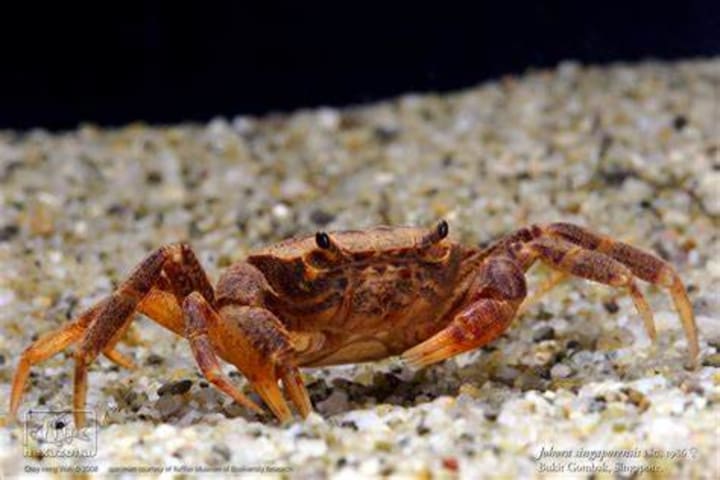
The Singapore Freshwater Crab (Johora singaporensis) is a critically endangered species of crab endemic to Singapore. It is one of the rarest and most threatened freshwater crabs in the world. The species was first discovered in 1986 and was formally described in 1991.
Physical Description:
The Singapore Freshwater Crab is a relatively small crab, with males reaching a carapace width of about 2.5 centimeters, while females are slightly larger. It has a dark brown to blackish carapace, which is broader than it is long. The body is relatively flat and elongated, with long and slender legs. The claws are well-developed and possess sharp tips. The species has a unique arrangement of short hairs on its body, which helps in distinguishing it from other freshwater crabs.
Habitat and Distribution:
This crab is restricted to a few small streams and tributaries in Singapore. It is primarily found in the central catchment area, which includes the Central Nature Reserve, MacRitchie Reservoir, and Bukit Timah Nature Reserve. These freshwater habitats are characterized by shaded forest streams with clear water and abundant vegetation. The crab prefers clean, cool, and well-oxygenated water.
Behavior and Diet:
The Singapore Freshwater Crab is primarily nocturnal and secretive, often hiding under rocks or within crevices during the day. It is an omnivorous species, feeding on a variety of food sources such as algae, detritus, small invertebrates, and plant matter. The crab uses its claws to gather and manipulate its food.
Conservation Status and Threats:
The Singapore Freshwater Crab is listed as critically endangered on the IUCN Red List of Threatened Species. It faces numerous threats to its survival due to the loss and degradation of its habitat. Urbanization, deforestation, and pollution have resulted in the decline of suitable freshwater habitats for the species. Additionally, the introduction of non-native fish species, such as the tilapia and snakehead fish, pose a threat to the crab's survival by predation and competition for resources.
Conservation Efforts:
Efforts have been made to conserve and protect the Singapore Freshwater Crab and its habitat. The National Parks Board (NParks) in Singapore has implemented measures to restore and maintain suitable habitats for the species. This includes the removal of non-native fish species, habitat restoration projects, and public awareness campaigns. Captive breeding programs have also been initiated to establish an ex-situ population as a safeguard against extinction.
Research and Monitoring:
Ongoing research and monitoring programs are essential for understanding the population dynamics, ecology, and conservation needs of the Singapore Freshwater Crab. Scientists and conservation organizations collaborate to study the crab's behavior, habitat requirements, and potential threats. These efforts help inform conservation strategies and management practices.
Public Awareness and Education:
Raising public awareness about the importance of freshwater ecosystems and the conservation of the Singapore Freshwater Crab is crucial. Educational initiatives, guided nature walks, and outreach programs aim to engage the local community in conservation efforts and promote responsible behavior towards the environment.
The Singapore Freshwater Crab (Johora singaporensis) serves as a flagship species for the conservation of freshwater habitats in Singapore. Its protection and the restoration of its habitat contribute to the overall biodiversity and ecological health of the region. Efforts to conserve this species are not only important for its survival but also for the preservation of Singapore's natural heritage.
6., Greater Mouse-Deer (Tragulus napu):

The Greater Mouse-Deer (Tragulus napu), also known as the Napu Mouse-Deer or Malay Mouse-Deer, is a small and elusive ungulate species belonging to the family Tragulidae. It is native to Southeast Asia and is found in various countries such as Indonesia, Malaysia, Thailand, and the Philippines.
Physical Description:
The Greater Mouse-Deer is one of the smallest hoofed mammals in the world. It has a compact and slender body, with a height of around 30 to 40 centimeters at the shoulder and a length of approximately 60 to 75 centimeters. The species exhibits sexual dimorphism, with males being slightly larger than females. The fur is reddish-brown to dark brown in color, blending well with the forest floor, and provides camouflage.
Habitat and Distribution:
This species inhabits a variety of forested habitats, including tropical rainforests, mangroves, swamps, and secondary forests. It is most commonly found in lowland areas but can also occur at higher elevations, up to around 1,500 meters. The Greater Mouse-Deer is distributed across Southeast Asia, with populations recorded in countries such as Indonesia (Sumatra, Borneo, Java), Malaysia (Peninsular Malaysia, Borneo), Thailand, and the Philippines.
Behavior and Diet:
The Greater Mouse-Deer is primarily a nocturnal and solitary animal, displaying a high degree of secrecy and agility. It is a herbivorous species, feeding on a variety of vegetation, including leaves, shoots, fruits, and flowers. Its small size allows it to maneuver through dense vegetation in search of food and shelter. When threatened, it can freeze or quickly flee by bounding in a zigzag pattern to escape predators.
Reproduction:
Little is known about the reproductive behavior of the Greater Mouse-Deer in the wild. It is believed to have a polygynous mating system, where dominant males mate with multiple females. Females have a gestation period of approximately five months and usually give birth to a single offspring, called a fawn. The fawn is precocial, meaning it is relatively mature and able to move shortly after birth.
Conservation Status and Threats:
The Greater Mouse-Deer is listed as Vulnerable on the IUCN Red List of Threatened Species. The species faces several threats that have led to population declines and habitat fragmentation. Deforestation, habitat loss due to agriculture and urbanization, and illegal hunting for meat and body parts are significant threats to its survival. The species is also vulnerable to predation by large carnivores and domestic dogs.
Conservation Efforts:
Conservation initiatives are underway to protect the Greater Mouse-Deer and its habitat. Efforts include the establishment and management of protected areas, such as national parks and wildlife reserves, which help safeguard important habitats for the species. Conservation organizations and governments work together to raise awareness, enforce hunting regulations, and promote sustainable land-use practices.
Research and Monitoring:
Research on the biology, ecology, and population dynamics of the Greater Mouse-Deer is crucial for effective conservation strategies. Scientists conduct field studies, population surveys, and monitoring programs to gather data on the species' distribution, abundance, and behavior. This information helps assess its conservation status and guides management decisions.
Public Awareness and Education:
Educating local communities, stakeholders, and the general public about the importance of conserving the Greater Mouse-Deer is vital for its long-term survival. Awareness campaigns, community engagement programs, and ecotourism initiatives help promote understanding and appreciation of this unique and threatened species.
7., Malayan Night Heron (Gorsachius melanolophus):
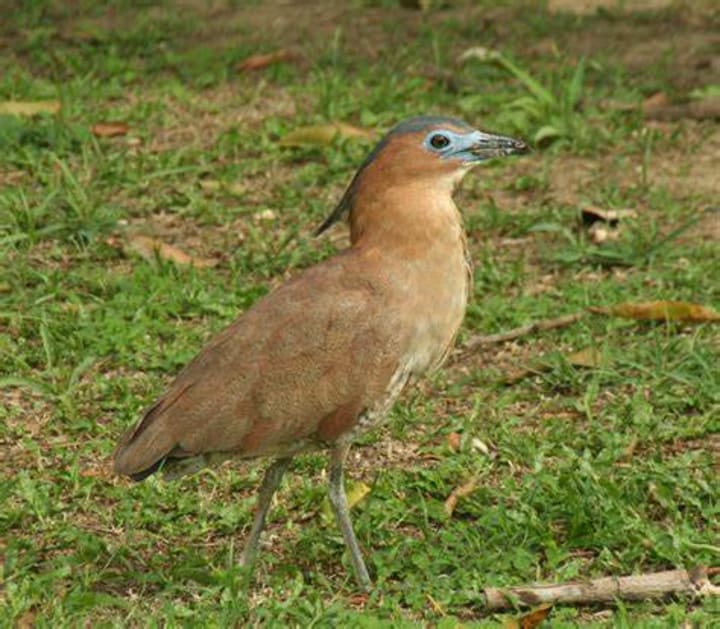
The Malayan Night Heron (Gorsachius melanolophus), also known as the Malaysian Night Heron or Malaysian Eared Night Heron, is a medium-sized heron species found in Southeast Asia. It belongs to the family Ardeidae and is known for its elusive nature and nocturnal habits.
Physical Description:
The Malayan Night Heron has a distinctive appearance with its unique plumage and prominent ear tufts. It measures about 55 to 60 centimeters in length and has a wingspan of approximately 80 centimeters. The adult bird has a black crown with elongated feathers that form ear tufts, giving it a distinctive "eared" appearance. The rest of its body is predominantly dark gray or black, and it has red eyes. The bill and legs are dark in color.
Habitat and Distribution:
This heron species is primarily found in dense tropical forests and wetland habitats, including swamps, mangroves, and peat forests. It is distributed across Southeast Asia, including countries such as Malaysia, Indonesia (Sumatra and Borneo), Thailand, Myanmar, Cambodia, Vietnam, and the Philippines. It is primarily a resident species, although some populations may undertake seasonal movements.
Behavior and Diet:
The Malayan Night Heron is a primarily nocturnal bird, spending the daylight hours in dense vegetation, roosting quietly and hidden from view. It becomes active at dusk and throughout the night, hunting for prey. Its diet consists mainly of small vertebrates, such as frogs, lizards, snakes, small mammals, and occasionally insects and crustaceans. It uses its sharp bill to catch and consume its prey.
Breeding and Reproduction:
The breeding behavior of the Malayan Night Heron is not well-documented. It is believed to breed during the monsoon season or rainy periods. The species builds a nest in trees or shrubs using twigs and leaves. The female typically lays two to three eggs, which are incubated by both parents for about 25 to 30 days. The chicks hatch with downy feathers and are cared for by the parents until they fledge.
Conservation Status and Threats:
The Malayan Night Heron is listed as Vulnerable on the IUCN Red List of Threatened Species. The species faces various threats that have contributed to its population decline. Loss and degradation of its habitat due to deforestation, conversion of wetlands, and agricultural expansion are significant threats. Additionally, hunting and disturbance from human activities pose further challenges to its survival.
Conservation Efforts:
Conservation efforts are underway to protect the Malayan Night Heron and its habitat. Several protected areas, such as national parks and wildlife reserves, encompass suitable habitats for the species. These areas help safeguard important breeding and foraging sites. Conservation organizations and governments work to raise awareness, enforce hunting regulations, and promote sustainable land-use practices.
Research and Monitoring:
Scientific research and monitoring programs play a crucial role in understanding the ecology, behavior, and population dynamics of the Malayan Night Heron. Researchers conduct field studies, surveys, and habitat assessments to gather data on the species' distribution, abundance, and habitat requirements. This information guides conservation strategies and management actions.
Public Awareness and Education:
Educating local communities, stakeholders, and the general public about the importance of conserving the Malayan Night Heron is essential for its long-term survival. Awareness campaigns, community engagement programs, and ecotourism initiatives help promote understanding and appreciation of this unique and threatened bird species.
The conservation of the Malayan Night Heron not only ensures the survival of an iconic and enigmatic bird species but also contributes to the overall biodiversity and ecological health of its habitat.
8., Banded Leaf Monkey (Presbytis femoralis femoralis):

The Banded Leaf Monkey (Presbytis femoralis femoralis), also known as the Sabah Leaf Monkey or Bornean Banded Langur, is a species of primate belonging to the family Cercopithecidae. It is endemic to the island of Borneo, specifically found in parts of Sabah, Malaysia.
Physical Description:
The Banded Leaf Monkey is a medium-sized monkey with a distinctive appearance. It has a robust body, measuring approximately 50 to 60 centimeters in length, with a long tail of about 60 to 80 centimeters. The fur coloration varies between individuals and age groups, but generally, it has a black body with striking white bands on its upper arms, thighs, and tail. The face is typically dark in color, with a prominent brow ridge, and the eyes are surrounded by white fur.
Habitat and Distribution:
This leaf monkey species inhabits a range of forested habitats, including lowland rainforests, hill forests, and riverine forests. It is primarily found in the northeastern part of Borneo, particularly in Sabah, Malaysia. Its distribution extends from the coastal regions to the interior areas, where suitable forested habitats are available.
Behavior and Diet:
The Banded Leaf Monkey is a diurnal and arboreal species, spending most of its time in the forest canopy. It is an agile climber and leaper, using its strong limbs and prehensile tail to navigate through the trees. The species is predominantly folivorous, feeding on a variety of leaves, fruits, flowers, and young shoots. It has specialized stomach chambers to aid in the digestion of plant material.
Social Structure:
Banded Leaf Monkeys live in social groups called troops, which usually consist of several adult females, their offspring, and a dominant male. Troops can range in size from a few individuals to more than 20 individuals. They engage in social behaviors such as grooming, vocalizations, and territorial defense. The dominant male plays a crucial role in protecting the troop and ensuring reproductive success.
Reproduction:
Breeding among Banded Leaf Monkeys can occur throughout the year, but peak breeding seasons may vary depending on local conditions. After a gestation period of about six months, females give birth to a single offspring. The newborn has golden or orange fur, which gradually darkens as it grows. Offspring remain dependent on their mothers for several months before becoming more independent.
Conservation Status and Threats:
The Banded Leaf Monkey is listed as Endangered on the IUCN Red List of Threatened Species. The species faces numerous threats that have led to population declines. Habitat loss and fragmentation due to deforestation, land conversion for agriculture, and logging pose significant challenges. Additionally, hunting and illegal wildlife trade contribute to the species' decline, as it is sometimes targeted for its meat or captured for the pet trade.
Conservation Efforts:
Conservation measures are being implemented to protect the Banded Leaf Monkey and its habitat. Efforts include the establishment and management of protected areas, such as national parks and wildlife reserves, which provide essential habitats for the species. Conservation organizations and governmental agencies work together to enforce regulations, raise awareness, and promote sustainable land-use practices.
Research and Monitoring:
Research on the ecology, behavior, and population dynamics of the Banded Leaf Monkey is essential for its conservation. Scientists conduct studies, surveys, and monitoring programs to gather data on the species' distribution, population size, and habitat requirements. This information helps inform conservation strategies and management plans.
Public Awareness and Education:
Educating local communities, stakeholders, and the general public about the importance of conserving the Banded Leaf Monkey is crucial. Awareness campaigns, community engagement programs, and ecotourism initiatives help promote
9., Lesser Adjutant Stork (Leptoptilos javanicus):

The Lesser Adjutant Stork, scientifically known as Leptoptilos javanicus, is a large wading bird belonging to the family Ciconiidae. It is commonly found in Southeast Asia and parts of the Indian subcontinent. Here are the full details about the Lesser Adjutant Stork:
Physical Description:
Size: The Lesser Adjutant Stork is one of the largest storks, measuring approximately 120-152 cm (47-60 inches) in height and having a wingspan of about 200-250 cm (79-98 inches).
Weight: They typically weigh around 4-5 kg (8.8-11 pounds), with males being slightly larger than females.
Plumage: Adults have predominantly dark gray or black feathers with a short, white neck and a large, naked, and wrinkled pinkish or yellowish head. The bill is thick, long, and yellow in color. The legs are long and dull gray.
Distribution and Habitat:
The Lesser Adjutant Stork is native to Southeast Asia and the Indian subcontinent. Its range extends from Nepal, India, and Sri Lanka to Myanmar, Thailand, Cambodia, Laos, Vietnam, Malaysia, and Indonesia.
They primarily inhabit wetland areas, including marshes, swamps, mangroves, floodplains, and riverbanks. They can also be found in open grasslands and agricultural fields.
Behavior and Adaptations:
Feeding: The Lesser Adjutant Stork is a carnivorous bird, mainly feeding on fish, frogs, reptiles, small mammals, large insects, and even carrion. It employs a slow and deliberate hunting technique, standing still for long periods and striking quickly with its bill to catch prey.
Social Behavior: They are typically solitary birds but may gather in small groups near abundant food sources. During the breeding season, they may form loose breeding colonies.
Flight: The Lesser Adjutant Stork is a strong flyer and can cover long distances during migration or in search of food. It flies with slow wing beats and its neck outstretched.
Vocalization: Their vocalizations consist of various harsh croaks, clattering, and hissing sounds.
Breeding and Reproduction:
Breeding Season: The breeding season for the Lesser Adjutant Stork varies across its range but generally occurs during the monsoon season or shortly after, between June and October.
Nesting: They build large stick nests high up in trees, often near water bodies. These nests can measure up to 1.5 meters (5 feet) in diameter. Both males and females participate in nest construction.
Eggs and Incubation: The female stork usually lays 1-3 eggs, which have a chalky white appearance. Both parents take turns incubating the eggs, which hatch after an incubation period of around 28-35 days.
Parental Care: Both parents are involved in raising the chicks, which are initially covered in white down feathers. The chicks fledge at around 70-80 days but may remain dependent on their parents for an extended period.
Conservation Status:
The Lesser Adjutant Stork is currently listed as "Endangered" on the International Union for Conservation of Nature (IUCN) Red List of Threatened Species.
The primary threats to their population include habitat loss due to urbanization, agriculture, and infrastructure development. Hunting and capture for the wildlife trade also contribute to their declining numbers.
Conservation efforts focus on protecting their wetland habitats, raising awareness about their ecological importance, and enforcing legislation against hunting and trading.
10., Singapore Freshwater Crab (Johora singaporensis):
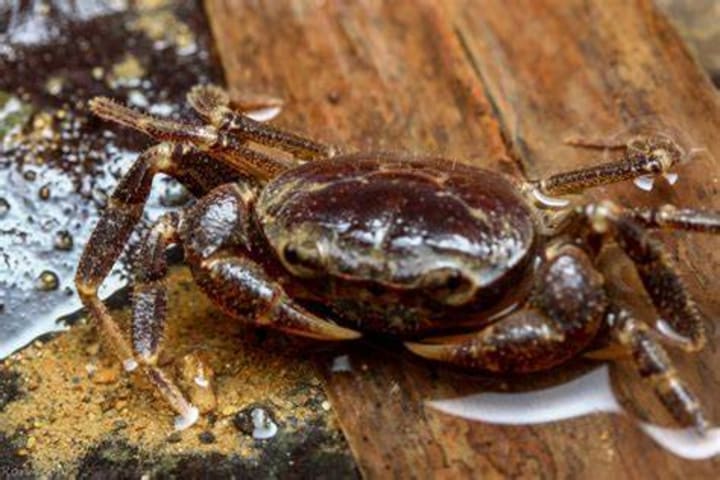
The Singapore Freshwater Crab, scientifically known as Johora singaporensis, is a species of freshwater crab endemic to the island of Singapore. It belongs to the family Gecarcinucidae. Here are the full details about the Singapore Freshwater Crab:
Physical Description:
Size: The Singapore Freshwater Crab is a relatively small crab, with males growing up to 2.5 centimeters (1 inch) in carapace width, while females are slightly larger.
Coloration: It has a dark brown or black carapace (the hard upper shell) with a distinctive pattern of light spots or stripes. The claws and legs are also dark brown.
Body Structure: The body is flattened and broad, with a rectangular-shaped carapace. The legs are stout and equipped with strong claws, which are used for feeding and defense.
Distribution and Habitat:
Endemic Range: The Singapore Freshwater Crab is found exclusively on the island of Singapore, making it a critically endangered species due to habitat loss and urbanization.
Habitat: It primarily inhabits freshwater streams, rivers, and reservoirs with slow-flowing or stagnant water. It prefers areas with rocky substrates and vegetation for cover.
Behavior and Adaptations:
Nocturnal: The Singapore Freshwater Crab is primarily nocturnal, being most active during the night and seeking shelter during the day.
Omnivorous Diet: It is an omnivorous species, feeding on a variety of food sources including detritus, algae, small invertebrates, and plant matter.
Burrowing Behavior: These crabs are known to be burrowers, constructing tunnels in the banks of rivers or streams for shelter and protection.
Reproduction and Life Cycle:
Breeding Behavior: The Singapore Freshwater Crab has a complex reproductive behavior. Males perform a courtship dance to attract females, waving their claws and making tapping sounds.
Larval Development: After mating, the female carries the eggs on her abdomen until they hatch into tiny larvae. These larvae are released into the water, where they undergo a series of molts and metamorphosis before becoming juveniles.
Growth and Lifespan: The crabs grow slowly and reach maturity at around 1-2 years of age. Their lifespan in the wild is estimated to be around 3-4 years.
Conservation Status:
The Singapore Freshwater Crab is listed as "Critically Endangered" on the IUCN Red List of Threatened Species.
Habitat Loss: The primary threat to its survival is the destruction and degradation of its freshwater habitats due to urbanization, deforestation, and pollution.
Conservation Efforts: Efforts are being made to conserve the species, including the establishment of protected areas, habitat restoration, and public awareness campaigns. Captive breeding programs and reintroduction into suitable habitats have also been initiated.
About the Creator
Enjoyed the story? Support the Creator.
Subscribe for free to receive all their stories in your feed. You could also pledge your support or give them a one-off tip, letting them know you appreciate their work.






Comments
There are no comments for this story
Be the first to respond and start the conversation.